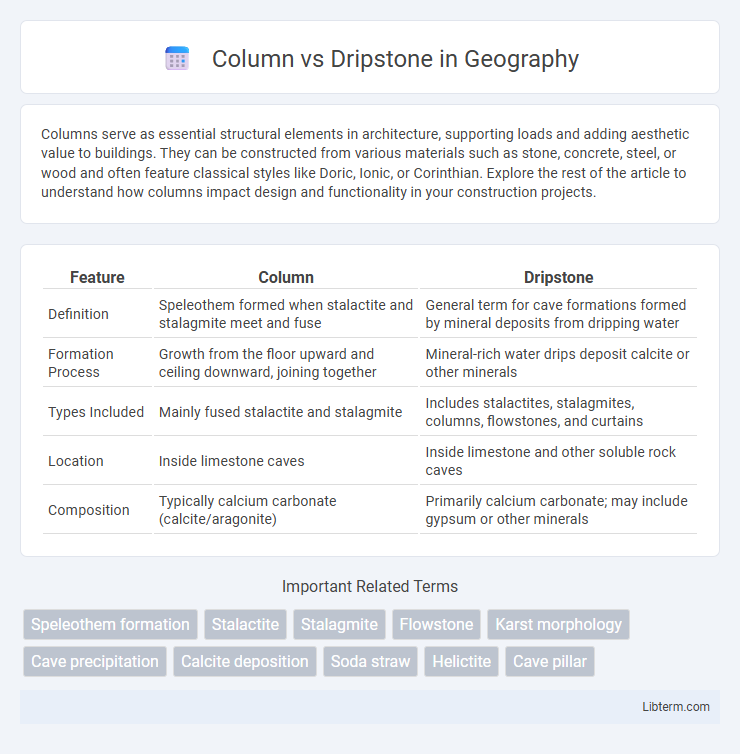Columns serve as essential structural elements in architecture, supporting loads and adding aesthetic value to buildings. They can be constructed from various materials such as stone, concrete, steel, or wood and often feature classical styles like Doric, Ionic, or Corinthian. Explore the rest of the article to understand how columns impact design and functionality in your construction projects.
Table of Comparison
| Feature | Column | Dripstone |
|---|---|---|
| Definition | Speleothem formed when stalactite and stalagmite meet and fuse | General term for cave formations formed by mineral deposits from dripping water |
| Formation Process | Growth from the floor upward and ceiling downward, joining together | Mineral-rich water drips deposit calcite or other minerals |
| Types Included | Mainly fused stalactite and stalagmite | Includes stalactites, stalagmites, columns, flowstones, and curtains |
| Location | Inside limestone caves | Inside limestone and other soluble rock caves |
| Composition | Typically calcium carbonate (calcite/aragonite) | Primarily calcium carbonate; may include gypsum or other minerals |
Introduction to Column and Dripstone
Columns are vertical structural elements commonly found in caves, formed when stalactites and stalagmites meet and merge over time, creating a continuous mineral deposit from floor to ceiling. Dripstones refer to a broader category of speleothems formed by mineral-rich water dripping and depositing calcite, including stalactites, stalagmites, and columns. Understanding the formation processes and mineral composition of columns and dripstones helps in studying cave geology and speleogenesis.
Defining Column: Formation and Characteristics
A column is a speleothem formed when stalactites and stalagmites grow until they meet, creating a continuous vertical mineral deposit in caves. It develops over thousands of years through mineral-rich water dripping and depositing calcite or other minerals, resulting in a solid structure that extends from cave floor to ceiling. Columns are characterized by their substantial thickness, seamless connection, and prominent presence, distinguishing them from individual dripstones that remain separate.
What is Dripstone? Types and Features
Dripstone refers to mineral deposits formed by the dripping of mineral-rich water, commonly found in caves as stalactites and stalagmites, showcasing natural calcite or aragonite formations. Types of dripstone include stalactites, which hang from ceilings, and stalagmites, which rise from cave floors, often merging over time to form columns. Key features of dripstone are its slow growth rate, layered crystalline structure, and its role as an indicator of past climatic conditions through isotopic analysis.
Geological Processes Behind Columns and Dripstones
Columns form in caves when stalactites and stalagmites grow until they meet, driven by mineral-rich water deposition over thousands of years. Dripstones, including stalactites and stalagmites, develop as calcium carbonate precipitates from dripping groundwater saturated with dissolved limestone. These geological processes result from the continuous interaction of groundwater with carbonate rock, influenced by factors like water chemistry, flow rate, and cave microclimate.
Key Differences: Column vs Dripstone
Columns are vertical, structural formations within caves formed by the union of stalactites and stalagmites, while dripstones refer more broadly to mineral deposits created by dripping water. Columns exhibit continuous growth from floor to ceiling, whereas dripstones include various formations such as stalactites (hanging) and stalagmites (rising). The key difference lies in columns being unified formations connecting cave surfaces, whereas dripstones represent separate deposits formed by mineral-laden water drops.
Visual Identification: How to Recognize Each Formation
Columns are formed by the joining of stalactites and stalagmites, creating a continuous pillar from ceiling to floor, easily recognized by their solid, often cylindrical shape. Dripstones, including stalactites and stalagmites individually, are identified by their distinct growth patterns--stalactites hang like icicles from the ceiling, while stalagmites rise up from the ground, often with a more irregular, rounded form. Visual identification hinges on noticing whether these features connect to form a column or remain separate dripstone formations.
Common Occurrences and Locations
Columns and dripstones commonly form in limestone caves where mineral-rich water deposits calcite. Columns develop when stalactites and stalagmites grow until they meet, frequently found in extensive cave systems like Carlsbad Caverns in the USA. Dripstones, encompassing both stalactites and stalagmites, are prevalent in karst regions worldwide, including the Yucatan Peninsula and the Mammoth Cave system.
Significance in Cave Ecosystems
Columns in cave ecosystems serve as vital structural supports formed by the fusion of stalactites and stalagmites, influencing microhabitats and water flow patterns. Dripstones, including stalactites and stalagmites, play a crucial role in nutrient cycling by trapping minerals and organic matter from dripping water, fostering microbial communities. Both formations contribute to the cave's ecological stability by regulating humidity levels and providing surfaces for specialized cave fauna.
Human Impact and Preservation
Columns and dripstones within caves face varying levels of human impact, with columns often more susceptible due to their accessibility and size. Preservation efforts prioritize minimizing physical contact and environmental changes that accelerate mineral dissolution or staining. Advanced monitoring techniques and controlled access protocols help maintain the structural integrity and aesthetic value of these speleothems.
Conclusion: Choosing Between Column and Dripstone
Choosing between column and dripstone formations depends on their specific geological characteristics and formation conditions. Columns form through the continuous deposition of mineral-rich water from floor to ceiling, creating a solid, unified structure, while dripstones develop from mineral deposits dripping from cave ceilings, forming stalactites and stalagmites separately. Understanding the formation environment, desired cave aesthetic, and structural stability helps in selecting the appropriate formation type for study or decoration purposes.
Column Infographic

 libterm.com
libterm.com